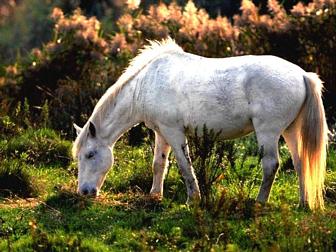
OVERVIEW
The Camargue is also known as "the horse of the sea" due to its native environment, the Rhone delta in southern France. The horse is said to be a primitive breed, but there is little documented evidence to back up this claim. Whether the Camargue is ancient or not, it does bear a strong resemblance to the primitive horses painted on the walls of the Lascaux cave dated at around 15,000 BC. Horse bones of an even earlier date were dug up in the 19th century near the Rhone delta, and claims have been made that these are the Camargue's ancestors. Whatever the background, the Camargue have lived in the marshy wasteland of the delta for thousands of years and are still used by the 'gardian,' (Camargue cowboy), to work with wild bulls and sheep.
PHYSICAL DESCRIPTION
The Camargue can hardly be said to be a horse of fine conformation. Regardless, the horse is an excellent mount, being very brave and enduring. The head is a coarse, heavy Oriental-type, thereby giving it a slightly primitive appearance. Although the Camargue doesn't exactly have the aesthetic look of the Arabian, it has a strong look with a short neck and straight, upright shoulders. The body is short and the hindquarters slight. The tail and mane are thick. The horse is gray in color and stands around 14 hh.
ORIGIN
As stated above, the certain origin of Camargue is unknown, but it is most likely of ancient origins. The Barb most likely exerted its influence at some point in the Camargue's history. The tack of the gardians is very similar to that used by the Moors - the high-pommelled saddle and cage stirrups - pointing to an equine influence which almost certainly traveled across the Iberian peninsula to the delta. The breed was finally officially recognized in 1968. Stud owners have since rounded up the horses from their semi-wild state for stud purposes.
INTERESTING FACTS
The Camargue, because of their courage and stamina, have for years made excellent cow horses for the gardian of the Provence. However, since the number of horses far exceeds the needs of the gardian, the Camargue have at times been slaughtered for meat. Today, with areas of the Rhone delta having been set aside as wildlife sanctuaries, the Camargue has reclaimed its homeland as well as establishing a purpose for itself as an ideal form of transportation throughout the marshland for the tourists. In addition, the gardians, known to be proud of their heritage, are helping to preserve the breed. By exhibiting breed's skills at local festivals, people are becoming aware of the breed.
INFLUENCE
1. Barb
2. Solutre
For more information:
Association Des Eleveurs de Chevaux
de Race Camargue
Mas du Pont de Rousty
13200 Arles
FRANCE